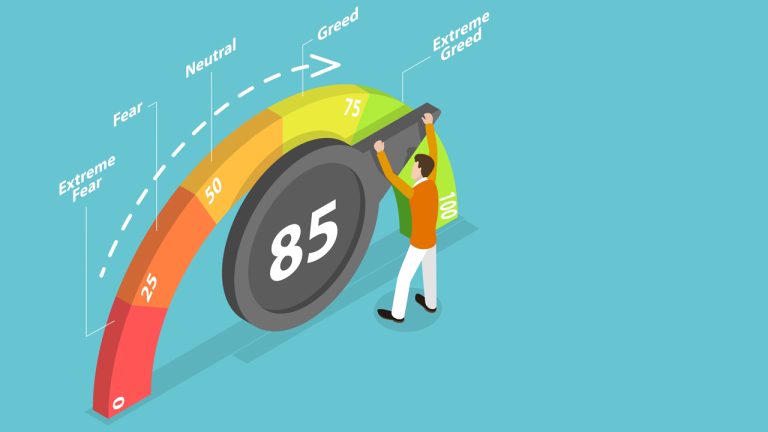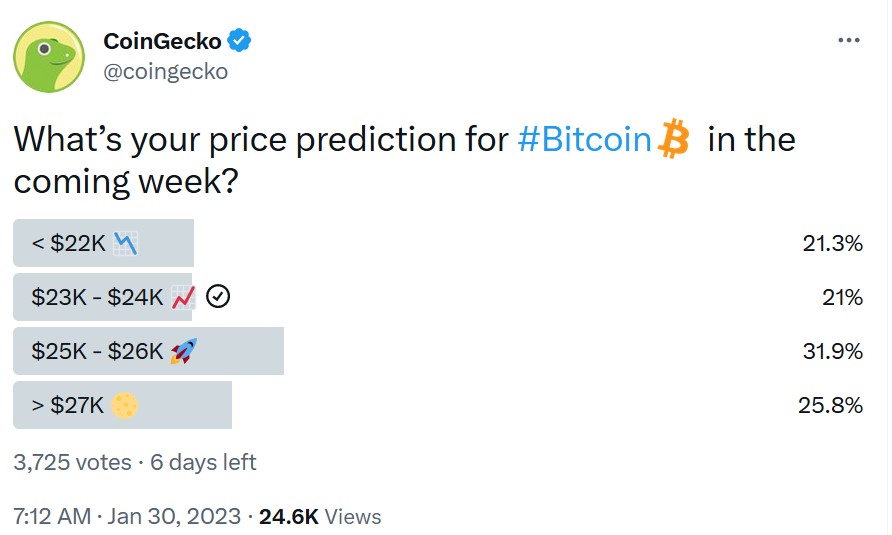 Over the past week, bitcoin has exhibited a downward trend, with its price stabilizing at around $62,950 to $63,125 per unit as of April 27. Despite this dip, the Crypto Fear and Greed Index remains firmly in the “greed” sector. According to Google Trends, interest in the term “bitcoin” has diminished, while the market intelligence […]
Over the past week, bitcoin has exhibited a downward trend, with its price stabilizing at around $62,950 to $63,125 per unit as of April 27. Despite this dip, the Crypto Fear and Greed Index remains firmly in the “greed” sector. According to Google Trends, interest in the term “bitcoin” has diminished, while the market intelligence […] In the past 24 hours, the cryptocurrency market experienced a modest increase of 2.16% against the U.S. dollar, with bitcoin’s value lingering slightly above the $69,000 threshold. The Crypto Fear and Greed Index (CFGI) indicates that the market’s mood remains in an “extreme greed” phase. Market Sentiment Swings Between ‘Greed’ and ‘Extreme Greed’ Despite Bitcoin’s […]
In the past 24 hours, the cryptocurrency market experienced a modest increase of 2.16% against the U.S. dollar, with bitcoin’s value lingering slightly above the $69,000 threshold. The Crypto Fear and Greed Index (CFGI) indicates that the market’s mood remains in an “extreme greed” phase. Market Sentiment Swings Between ‘Greed’ and ‘Extreme Greed’ Despite Bitcoin’s […]
Two key Bitcoin price metrics suggest that bulls will be able to hold the $30,000 level as support.
Bitcoin (BTC) has been trading above $31,000 after its 24.3% rally between June 15 and June 23, which caught many off guard. For bears, that meant facing $165 million in short futures contract liquidations, but the unexpected rally also brought some degree of discomfort for investors using Bitcoin derivatives.
Inflation remains the biggest question mark for traditional markets, a point highlighted by the recent 50-basis-point interest rate increase by the Bank of England, followed by similar moves in Norway and Switzerland, leading to the highest cost of capital in over a decade for the region.
In response to questions from lawmakers on the United States House Financial Services Committee on June 21, Federal Reserve Chair Jerome Powell said that “the process of getting inflation back down to 2% has a long way to go” and reiterated that “nearly all FOMC participants expect that it will be appropriate to raise interest rates somewhat further by the end of the year.”
According to JPMorgan strategists led by Marko Kolanovic, “the economy’s recent resilience may delay the onset of a recession,” so the impacts of the monetary tightening movement by the central bank are yet to be felt, “and ultimately a recession will likely be necessary to return inflation to target.”
Investors now question whether Bitcoin has the strength to trade above the $30,000 resistance amid the bearish pressure emerging from a potential economic recession and further central bank activity aimed at curbing the demand for capital.
Consequently, traders should closely monitor Bitcoin futures contract premiums and the costs of hedging using BTC options.
Bitcoin quarterly futures are popular among whales and arbitrage desks. However, these fixed-month contracts typically trade at a slight premium to spot markets, indicating that sellers are asking for more money to delay settlement.
As a result, BTC futures contracts in healthy markets should trade at a 5% to 10% annualized premium — a situation known as contango, which is not unique to crypto markets.

The demand for leveraged BTC longs slightly increased as the futures contract premium jumped to 4.3% on June 22 from 3.2% one week prior, although it remains below the neutral 5% threshold.
Traders should also analyze options markets to understand whether the recent correction has caused investors to become more optimistic. The 25% delta skew is a telling sign of when arbitrage desks and market makers overcharge for upside or downside protection.
In short, if traders anticipate a Bitcoin price drop, the skew metric will rise above 7%, and phases of excitement tend to have a negative 7% skew.

The 25% delta skew metric did a complete turnaround as it exited the “fear” mode on June 16 as Bitcoin’s price reclaimed the $26,000 support. The indicator continued to improve until June 22, culminating with the moderate “greed” sentiment at a negative 8% skew.
Related: ‘Bitcoin-only’ buy-and-hold investing outperforms altcoins over long term, analysis shows
Typically, a 4.3% futures basis and a negative 8% delta skew would be considered neutral market indicators, but that is not the case given the 21.5% Bitcoin price rally between June 15 and June 22. A certain amount of skepticism is healthy for buyers using derivatives contracts and opens room for further leverage use if needed.
The heated legal battle between Binance and the U.S. Securities and Exchange Commission presents a risk for BTC futures contracts. The decisions from the U.S. District Court for the District of Columbia could severely impact the cryptocurrency market, as Binance holds the biggest market share in the spot and derivatives markets.
Uncertainty around the crypto regulatory environment and the growing risks of an economic recession are possible explanations for Bitcoin derivatives traders’ lack of excitement.
Apart from those external risks, there is no apparent driver to justify a sharp BTC price correction, giving bulls just the right amount of optimism to keep the positive momentum.
This article is for general information purposes and is not intended to be and should not be taken as legal or investment advice. The views, thoughts, and opinions expressed here are the author’s alone and do not necessarily reflect or represent the views and opinions of Cointelegraph.
This article does not contain investment advice or recommendations. Every investment and trading move involves risk, and readers should conduct their own research when making a decision.
 Last month, statistics showed that the Crypto Fear and Greed Index (CFGI) had a score of 25, indicating “extreme fear.” Thirty days later, with a 39% increase in bitcoin prices against the U.S. dollar, the current CFGI score on Jan. 30, 2023, is 61, reflecting “greed.” Crypto Fear Index Jumps to ‘Greed,’ Etoro Market Analyst […]
Last month, statistics showed that the Crypto Fear and Greed Index (CFGI) had a score of 25, indicating “extreme fear.” Thirty days later, with a 39% increase in bitcoin prices against the U.S. dollar, the current CFGI score on Jan. 30, 2023, is 61, reflecting “greed.” Crypto Fear Index Jumps to ‘Greed,’ Etoro Market Analyst […]
Bitcoin's huge price surge in January has meant that 64% of Bitcoin investors are in profit, according to data from IntoTheBlock.
Bitcoin (BTC) has just clocked its 11th consecutive day outside the “Fear” zone in the Crypto Fear and Greed Index, cementing its longest streak out of fear since last March.
Bitcoin Fear and Greed Index is 61 - Greed
— Bitcoin Fear and Greed Index (@BitcoinFear) January 30, 2023
Current price: $23,780 pic.twitter.com/U5gxN3AwnT
This comes as Bitcoin hit $23,955 at 8:10 pm UTC time on Jan. 29, its highest level of the year. It has since come back down slightly, to $23,687 at the time of writing.
Meanwhile, Bitcoin sentiment is currently sitting firmly in the “Greed” zone with a score of 61, its highest level since the height of the bull run around Nov. 16, 2021, when its price was about $65,000.

However, despite Bitcoin’s strong resurgence in recent weeks, market participants continue to debate whether the recent price surge is part of a bull trap or whether there is a real chance for a bull run.
Regardless, the current rally has pushed a lot more BTC holders back into the green.
According to data from blockchain intelligence platform IntoTheBlock, 64% of Bitcoin investors are now in profit.
Those who first bought BTC back in 2019 are now — on average — back in profit too, according to on-chain analytics platform Glassnode.
We can calculate the average acquisition price for #Bitcoin by tracking exchange withdrawals.
— glassnode (@glassnode) January 29, 2023
The chart below shows the average withdrawal price for investors for each year.
The average class of 2019+ $BTC is now back in profit (at $21.8k)
Live Chart: https://t.co/yuhvydV70c pic.twitter.com/skjrM6w5lH
The average first-time buy price for BTC investors in 2019 was $21,800, which means those investors are on average up about 9% at the Jan. 29 price of $23,687.
Related: Bitcoin eyes $25K as BTC price nears best weekly close in 5 months
Meanwhile, a Jan. 29 poll from crypto market platform CoinGecko has revealed that 57.7% of 3,725 voters believe BTC will exceed $25,000 this week, while only 21.2% of voters believe BTC is primed for a pullback below $22,000.

The founder and CEO of Vailshire Capital, Dr. Jeff Ross, also provided a technical analysis of his own on Jan. 29, suggesting that a price surge toward $25,000 in the short term may be on the cards:
The strength of #bitcoin on the 4-hour charts continues to be impressive.
— Dr. Jeff Ross (@VailshireCap) January 29, 2023
While price action has trended sideways for over a week, short term indicators (MACD, RSI) have once again reset... and are now ramping higher.
A price surge to ~$25k is probable.
(Not investment advice) pic.twitter.com/QaPbNrxtxZ
Other analysts have called for excited investors to taper some of their expectations, however.
Head analyst Joe Burnett of Bitcoin mining company Blockware told his 43,900 Twitter followers on Jan. 29 that BTC won’t reach and surpass its all-time high of $69,000 until after the next Bitcoin halving event, which is expected to take place in March 2024:
I do not think Bitcoin will make a new all time high until after the 2024 halving.
— Joe Burnett ()³ (@IIICapital) January 29, 2023
Dovish macro conditions and decreased miner sell pressure will lead to the next parabolic bull run.
Using Energy Gravity as a potential top indicator, I expect the next peak to be $150k - $350k. pic.twitter.com/OfCER7s8Zq
Macroeconomist and investment adviser Lyn Alden also recently told Cointelegraph that there may be “considerable danger ahead” with potentially risky liquidity conditions expected to shake the market in the second half of 2023.
 After the Crypto Fear and Greed Index (CFGI) dropped to significant lows and pointed to “extreme fear” in crypto markets at the end of May, and throughout most of June, today the CFGI rating is still in the “fear” zone, but it has seen an improvement. On June 19, the CFGI rating tapped a low […]
After the Crypto Fear and Greed Index (CFGI) dropped to significant lows and pointed to “extreme fear” in crypto markets at the end of May, and throughout most of June, today the CFGI rating is still in the “fear” zone, but it has seen an improvement. On June 19, the CFGI rating tapped a low […]
The total crypto market capitalization is rising toward $1.25 trillion, but an assortment of metrics show retail and institutions are not ready to “ape.”
An ascending triangle formation has driven the total crypto market capitalization toward the $1.2 trillion level. The issue with this seven-week-long setup is the diminishing volatility, which could last until late August. From there, the pattern can break either way, but Tether and futures markets data show bulls lacking enough conviction to catalyze an upside break.

Investors cautiously await further macroeconomic data on the state of the economy as the United States Federal Reserve (FED) raises interest rates and places its asset purchase program on hold. On Aug. 12, the United Kingdom posted a gross domestic product (GDP) contraction of 0.1% year-over-year. Meanwhile, inflation in the U.K. reached 9.4% in July, the highest figure seen in 40 years.
The Chinese property market has caused the Fitch Ratings credit agency to issue a “special report” on Aug. 7 to quantify the impact of prolonged distress on a potentially weaker economy in China. Analysts expect asset management and smaller construction and steel-producing companies to suffer the most.
In short, risk asset investors are anxiously waiting for the Federal Reserve and Central Banks across the world to signal that the policy of tightening is coming to an end. On the other hand, expansionary policies are more favorable for scarce assets, including cryptocurrencies.
The risk-off attitude caused by increased interest rates has instilled a bearish sentiment into cryptocurrency investors since mid-April. As a result, traders have been unwilling to allocate to volatile assets and sought shelter in U.S. Treasuries, even though their returns do not compensate for inflation.

The Fear and Greed Index hit 6/100 on June 19, near the lowest ever reading for this data-driven sentiment gauge. However, investors moved away from the “extreme fear” reading during August as the indicator held a 30/100 level. On Aug. 11, the metric finally entered a “neutral” area after a fou-month-long bearish trend.
Below are the winners and losers from the past seven days as the total crypto capitalization increased 2.8% to $1.13 trillion. While Bitcoin (BTC) presented a mere 2% gain, a handful of mid-capitalization altcoins jumped 13% or more in the period.

Celsius (CEL) jumped 97.6% after Reuters reported that Ripple Labs displayed interest in acquiring Celsius Network and its assets which are currently under bankruptcy.
Chainlink (LINK) rallied 17% after announcing on Aug. 8 that it would no longer support the upcoming Ethereum proof-of-work (PoW) forks that occur during the Merge.
Avalanche (AVAX) gained 14.6% after being listed for trading on Robinhood on Aug. 8.
Curve DAO (CRV) lost 6% after the nameserver for the Curve.Fi website was compromised on Aug 9. The team quickly addressed the problem, but the front-end hack caused some of its users' losses.
The OKX Tether (USDT) premium is a good gauge of China-based retail crypto trader demand. It measures the difference between China-based peer-to-peer (P2P) trades and the United States dollar.
Excessive buying demand tends to pressure the indicator above fair value at 100% and during bearish markets Tether’s market offer is flooded and causes a 4% or higher discount.

On Aug. 8, the Tether price in Asia-based peer-to-peer markets entered a 2% discount, signaling moderate retail selling pressure. More importantly, the metric has failed to improve while the total crypto capitalization gained 9% in 10 days, indicating weak demand from retail investors.
To exclude externalities specific to the Tether instrument, traders must also analyze futures markets. Perpetual contracts, also known as inverse swaps, have an embedded rate that is usually charged every eight hours. Exchanges use this fee to avoid exchange risk imbalances.
A positive funding rate indicates that longs (buyers) demand more leverage. However, the opposite situation occurs when shorts (sellers) require additional leverage, causing the funding rate to turn negative.

Perpetual contracts reflected a neutral sentiment after Bitcoin and Ether held a slightly positive (bullish) funding rate. The current fees imposed on bulls are not concerning and resulted in a balanced situation between leveraged longs and shorts.
According to derivatives and trading indicators, investors are less inclined to increase their positions at current levels, as shown by the Tether discount in Asia and the absence of a positive funding rate in futures markets.
These neutral-to-bearish market indicators are worrisome, given that total crypto capitalization has been in a seven-week uptrend. Investors’ distress over Chinese property markets and further FED tightening movements is the most likely explanation.
For now, the odds of the ascending triangle breaking above the projected $1.25 trillion mark seem low, but further macroeconomic data is needed to estimate the direction central banks might take.
The views and opinions expressed here are solely those of the author and do not necessarily reflect the views of Cointelegraph. Every investment and trading move involves risk. You should conduct your own research when making a decision.

A key derivatives metric used by margin traders has hit a record-high, but there’s plenty of risk and a catch to consider.
Bitcoin (BTC) has been unable to close above $32,000 for the past 28 days, frustrating bulls and pushing the Fear and Greed index to bearish levels below 10. Even with June 6’s small boost, the tech-heavy Nasdaq stock market index is down 24% year-to-date.
Investors who keep a close eye on regulatory development were possibly scared after New York state made clear its intention to regulate the crypto industry, including Bitcoin mining.
On June 2, New York Attorney General Attorney Letitia James issued an investor alert against "risky cryptocurrency investments," citing the assets' volatility. According to Cointelegraph, the attorney general is convinced that crypto investments create "more pain than gain" for investors.
The New York State Senate approved a proof-of-work (PoW) mining ban on June 2 and the proposed controversial bill aims to prohibit any new mining operations in the state for the next two years and is now headed for the governor's desk.
Interestingly, as all of this takes place, Bitcoin derivatives traders have never been so bullish, according to one metric.
Margin trading allows investors to leverage their positions by borrowing stablecoins and using the proceeds to buy more cryptocurrency. When those savvy traders borrow Bitcoin, they use the coins as collateral for shorts, meaning they are betting on a price decrease.
That is why some analysts monitor the total lending amounts of Bitcoin and stablecoins to gain insight into whether investors are leaning bullish or bearish. Interestingly, Bitfinex margin traders entered their highest ever leverage long (bull) position on June 6.

Bitfinex margin traders are known for creating position contracts of 20,000 BTC or higher in a very short time, indicating the participation of whales and large arbitrage desks.
Notice that the longs (bull) indicator vastly increased in mid-May and currently stands at 90,090 BTC contracts, its highest-ever registry. To understand how severe this movement was, one might compare it to the June–July 2021 previous all-time high of 54,500 BTC contracts in longs.
These traders hit the bullseye as their bullish positions peaked right as Bitcoin price bottomed. Over the subsequent months, they could sell those long (bull) contracts at a profit, reducing the number of open long positions (blue line).
One might assume that these whales and arbitrage desks trading at Bitfinex margin markets have better timing (or knowledge), and thus it makes sense to follow their steps. However, if we analyze the same metric for 2019 and 2020, a completely different scenario emerges.

There were three hikes in the number of Bitfinex BTC margin longs this time around. The first instance happened between mid-November and mid-December 2019 after the indicator jumped from 25,200 BTC to 47,600 BTC longs. However, over the next month, the Bitcoin price failed to break above $8,300 and these traders closed their positions with minimal gains.
The next wave of BTC longs took place in early-February 2020, but those traders were caught by surprise after the Bitcoin price failed to break $10,500, forcing them to close their margin positions at a considerable loss.
Bitfinex BTC margin longs increased from 22,100 to 35,700 contracts in late-July 2020. The movement coincided with the price rally to $47,000, so the early entrants might have scored some profit, but most of the investors exited their margin longs with no gains.
To put things in perspective, over the previous four instances where BTC margin longs (bulls) significantly increased, investors had 1 profitable trade, 2 mostly neutral, and 1 considerable loss.
Some might say odds still favor those tracking the indicator, but one must remember that whales and arbitrage desks could easily crash the market when closing their positions. In such cases, those following the strategy might arrive late to the party and come out at a loss.
Will the current Bitfinex margin longs increase result in extreme profits? It might depend on how traditional markets, mainly tech stocks, perform over the next couple of weeks.
The views and opinions expressed here are solely those of the author and do not necessarily reflect the views of Cointelegraph. Every investment and trading move involves risk. You should conduct your own research when making a decision.
 For a few weeks now, bitcoin sentiment stemming from the Crypto Fear and Greed Index (CFGI) has been in the “extreme fear” range. While bitcoin gathered some gains on Monday, the CFGI is still in the “extreme fear” position with a ranking score of 16 out of 100. Crypto Fear and Greed Index Remains in […]
For a few weeks now, bitcoin sentiment stemming from the Crypto Fear and Greed Index (CFGI) has been in the “extreme fear” range. While bitcoin gathered some gains on Monday, the CFGI is still in the “extreme fear” position with a ranking score of 16 out of 100. Crypto Fear and Greed Index Remains in […]
Traders are calling for a “relief rally” to $35,000, but derivatives data shows bears stand to profit from this week’s $1.81 billion BTC options expiry.
Bitcoin (BTC) price has been unable to close above $32,000 for the past fifteen days and is currently down 37% year-to-date. Although that might seem excessive, it does not stand out among some of the largest U.S.-listed tech companies which have also sustained notable losses recently.
In this same 15-day period, Shopify Inc. (SHOP) stock dropped 76%, Snap Inc. (SNAP) crashed 73%, Netflix (NFLX) is down 70% and Cloudflare (NET) presented a negative 62% performance.
Cryptocurrency investors should be less concerned about the current "bear market" considering Bitcoin's 79% annualized volatility. However, that is clearly not the case, because Bitcoin's "Fear and Greed Index" reached an 8 out of 100 on May 17, the lowest level since March 2020.
Traders fear that worsening macroeconomic conditions could cause investors to seek shelter in the U.S. dollar and Treasuries. Japan’s industrial production data released on May 18 showed a 1.7% contraction year over year. Moreover, May 20 retail sales data from the United Kingdom showed a 4.9% decline versus 2021.
Financial analysts across the globe blame the weakened market conditions on the U.S. Federal Reserve's slow reaction to the inflation surge. Thus, traders increasingly seek shelter outside of riskier assets, which negatively impacts Bitcoin price.
The open interest for the monthly May 27 options expiry in Bitcoin is $1.81 billion, but the actual figure will be lower since bulls were caught by surprise as the BTC price has fallen 26% in the last 30 days.

The 1.31 call-to-put ratio reflects the $1.03 billion call (buy) open interest against the $785 million put (sell) options. Nevertheless, 94% of the bullish bets will likely become worthless as Bitcoin currently trades near $30,000.
If Bitcoin's price remains below $31,000 on May 27, bulls will only have $60 million worth of these call (buy) options available. This difference happens because there is no use in a right to buy Bitcoin at $31,000 if it trades below that level on expiry.
Related: Low inflation or bust: Analysts say the Fed has no choice but to continue raising rates
Below are the three most likely scenarios based on the current price action. The number of options contracts available on May 27 for call (buy) and put (sell) instruments varies, depending on the expiry price. The imbalance favoring each side constitutes the theoretical profit:
This crude estimate considers the call options used in bullish bets and the put options exclusively in neutral-to-bearish trades. Even so, this oversimplification disregards more complex investment strategies.
For example, a trader could have sold a call option, effectively gaining negative exposure to Bitcoin above a specific price, but unfortunately, there's no easy way to estimate this effect.
Bitcoin bears need to sustain the price below $30,000 on May 27 to profit $390 million from the monthly options expiry. On the other hand, bulls can reduce their loss by pushing BTC above $32,000, an 8% rally from the current $29,700 price. However, judging by the bearish macroeconomic conditions, bears seem better positioned for May 27 expiry.
The views and opinions expressed here are solely those of the author and do not necessarily reflect the views of Cointelegraph. Every investment and trading move involves risk. You should conduct your own research when making a decision.